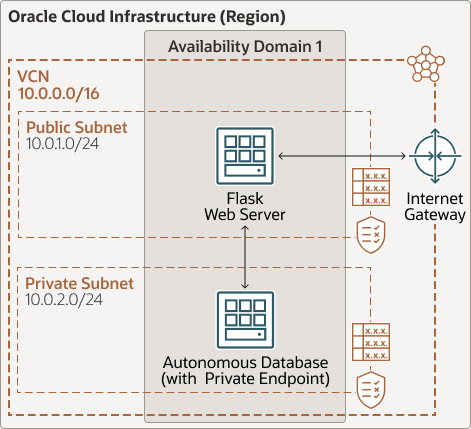Thủ Thuật về Which three Oracle cloud infrastructure resources do you need to configure before provisioning your autonomous database with private endpoint? 2022
Bạn đang tìm kiếm từ khóa Which three Oracle cloud infrastructure resources do you need to configure before provisioning your autonomous database with private endpoint? được Cập Nhật vào lúc : 2022-10-23 10:20:22 . Với phương châm chia sẻ Bí quyết Hướng dẫn trong nội dung bài viết một cách Chi Tiết Mới Nhất. Nếu sau khi đọc tài liệu vẫn ko hiểu thì hoàn toàn có thể lại Comment ở cuối bài để Mình lý giải và hướng dẫn lại nha.
Enable private access to a fully managed, autonomous database in Oracle Cloud Infrastructure in a private subnet. This will assign a private IP to the autonomous database for access.
Nội dung chính
- Architecture
- Recommendations
- Considerations
- Explore More
- Which are the three pre requisites to configure a private endpoint with autonomous databases?
- Which three security features are available in Oracle autonomous database shared infrastructure choose three?
- What are three platforms where Oracle autonomous database service can be deployed?
- Which three statements are true when provisioning an autonomous database?
Architecture
This architecture shows a public-facing Flask web server connected to an autonomous database with a private endpoint provisioned in Oracle Cloud Infrastructure.

Description of the illustration
autonomous-db-private-endpoint.png
autonomous-db-private-endpoint-oracle.zip
The architecture has the following components:
- Autonomous database, with a private endpoint
This architecture uses an autonomous database (which can be an Oracle
Autonomous Transaction Processing database or an Oracle Autonomous Data Warehouse) provisioned in a private subnet; that is with a private endpoint. - Region
An Oracle Cloud Infrastructure region is a localized geographic area that contains one or more data centers, called availability domains. Regions are independent of other regions, and vast distances can separate them (across countries or even continents).
- Availability
domainsAvailability domains are standalone, independent data centers within a region. The physical resources in each availability domain are isolated from the resources in the other availability domains, which provides fault tolerance. Availability domains don’t share infrastructure such as power or cooling, or the internal availability domain network. So, a failure one availability domain is unlikely to affect the other availability domains in the region.
- Virtual
cloud network (VCN) and subnetsA VCN is a customizable, software-defined network that you set up in an Oracle Cloud Infrastructure region. Like traditional data center networks, VCNs give you complete control over your network environment. A VCN can have multiple non-overlapping CIDR blocks that you can change after you create the VCN. You can segment a VCN into subnets, which can be scoped to a region or to an availability domain. Each subnet consists of a contiguous
range of addresses that don’t overlap with the other subnets in the VCN. You can change the size of a subnet after creation. A subnet can be public or private.In this architecture, the web server is attached to a public subnet, and the autonomous database is in a private subnet.
Recommendations
Your requirements might differ from the architecture described here. Use the following
recommendations as a starting point.
- Compute shapes
This architecture uses an Oracle Linux 7.7 compute instance with a VM.Standard2.1 shape for the Flask-based server. If the application needs more processing power, memory, or network bandwidth, then choose a larger shape.
- VCN
When you create a VCN, determine the number of CIDR blocks required and the size of each block based on
the number of resources that you plan to attach to subnets in the VCN. Use CIDR blocks that are within the standard private IP address space.After you create a VCN, you can change, add, and remove its CIDR blocks.
- Autonomous database
In this architecture, the application stores relational data in an autonomous database. We recommend using the latest version of Oracle Database.
Considerations
- Web-server scalability
You can scale your Flask application by using the compute instance pool and autoscaling features.
Instance pools let you provision and create multiple compute instances based on the same configuration, within the same region.
Autoscaling lets you automatically adjust the number of compute instances in
an instance pool based on performance metrics, such as CPU utilization. Autoscaling helps you provide consistent performance for users during periods of high demand and helps you reduce cost during periods of low demand. - Autonomous database scalability
You can manually scale the database’s base number of CPU cores up or down any time. The autoscaling feature allows your database to use up to three times the current base number of CPU cores any time. As demand
increases, autoscaling automatically increases the number of cores in use. You can scale the storage capacity of the database any time without affecting availability or performance. - Application availability
Fault domains provide the best resiliency within an availability domain. If you need higher availability, consider using multiple availability domains or multiple regions.
- Autonomous database backups
Your autonomous database is backed
up automatically, and the backups are retained for 60 days. You can restore and recover the database to any point-in-time during the retention period.You can also create manual backups to supplement the automatic backups. Manual backups are stored in a bucket that you create in Oracle Cloud Infrastructure Object Storage, and the backups are retained for 60 days.
- Compute backups
The Oracle Cloud Infrastructure Block Volumesservice lets
you make point-in-time backups of data on a block volume. You can then restore the backups to new volumes either immediately or later.You can also use the service to make a point-in-time, crash-consistent backup of a boot volume without application interruption or downtime. Boot volume backup capabilities are the same as block volume backup capabilities.
- Security
- Policies
Use
policies to restrict who can access your Oracle Cloud Infrastructure resources and what operations they can perform. - Network security
The networking service offers two virtual firewall features that use security rules to control traffic the packet level: security lists and network security groups (NSG).
An NSG consists of a set of ingress and egress security rules that apply to only a set of VNICs of your choice within
a VCN. For example, an NSG can include the VNICs of all the compute instances in the web tier of a multitier application.NSG security rules function the same as security list rules. However, for an NSG security rule’s source or destination, you can specify an NSG instead of a CIDR block. So, you can easily write security rules to control traffic between two NSGs in the same VCN or traffic within a single NSG.
When you provision the autonomous database in Oracle Cloud
Infrastructure, you can specify one or more NSGs. You can also update an existing database to use one or more NSGs.
- Policies
Deploy
The Terraform code for this reference architecture is available in GitHub. You can pull the code into Oracle Cloud Infrastructure Resource Manager with a single click, create the stack, and deploy it. Alternatively, you can tải về the code from
GitHub to your computer, customize the code, and deploy the architecture by using the Terraform CLI.
- Deploy by using Oracle Cloud Infrastructure Resource Manager:
- Click

If you aren’t already signed in, enter the tenancy and user credentials.
- Review and accept the terms and conditions.
- Select the region where you want to deploy the stack.
- Follow the on-screen prompts and instructions to create the stack.
- After creating the stack, click Terraform Actions, and select Plan.
- Wait for the job to be completed, and review the plan.
To make any changes, return to the Stack Details page, click Edit Stack, and make the required changes. Then, run the
Plan action again. - If no further changes are necessary, return to the Stack Details page, click Terraform Actions, and select Apply.
- Deploy by using the Terraform CLI:
- Go to GitHub.
- Download or clone
the code to your local computer. - Follow the instructions in the README.
Explore More
- Configure Private Endpoints with Autonomous Database
- Deploy a highly available web application
- Best practices framework for Oracle Cloud Infrastructure
Change Log
This log lists only the significant changes:
May 5, 2022
Added the option to tải về editable versions (.SVG and .DRAWIO) of the architecture diagram.
April 20, 2022
Updated the link to deploy the architecture by using Oracle Cloud Infrastructure Resource Manager.
November 4, 2022
Added steps to deploy the architecture by using Oracle Cloud Infrastructure Resource Manager.
Which are the three pre requisites to configure a private endpoint with autonomous databases?
Creating an Autonomous Database with a Private Endpoint. A virtual cloud network (VCN) in the region where you want to create the Autonomous Database. … . At least one subnet in the VCN.. At least one network security group (NSG) in the VCN..
Which three security features are available in Oracle autonomous database shared infrastructure choose three?
To establish a connection, the Client Credentials (Wallet) is needed, which can be downloaded after Autonomous Database creation.. Transparent Data Encryption (TDE) TDE enables you to encrypt data on storage truyền thông. … . Backup Encryption. Backups are taken automatically. … . SQL*Net Encryption..
What are three platforms where Oracle autonomous database service can be deployed?
Built on Oracle Database and Oracle Exadata, Autonomous Database is available on Oracle Cloud Infrastructure (OCI) for shared or dedicated deployments, and on-premises with Exadata [email protected] and Dedicated Region [email protected]
Which three statements are true when provisioning an autonomous database?
Which THREE statements are TRUE when provisioning an Autonomous Database? (Choose all correct answers) The provisioned database is fully encrypted. It is deployed on a private software-defined network. The provisioned database automatically masks user data.
Tải thêm tài liệu liên quan đến nội dung bài viết Which three Oracle cloud infrastructure resources do you need to configure before provisioning your autonomous database with private endpoint?




Share Link Cập nhật Which three Oracle cloud infrastructure resources do you need to configure before provisioning your autonomous database with private endpoint? miễn phí
Bạn vừa Read Post Với Một số hướng dẫn một cách rõ ràng hơn về Review Which three Oracle cloud infrastructure resources do you need to configure before provisioning your autonomous database with private endpoint? tiên tiến và phát triển nhất và Chia SẻLink Download Which three Oracle cloud infrastructure resources do you need to configure before provisioning your autonomous database with private endpoint? miễn phí.

Thảo Luận vướng mắc về Which three Oracle cloud infrastructure resources do you need to configure before provisioning your autonomous database with private endpoint?
Nếu sau khi đọc nội dung bài viết Which three Oracle cloud infrastructure resources do you need to configure before provisioning your autonomous database with private endpoint? vẫn chưa hiểu thì hoàn toàn có thể lại Comments ở cuối bài để Admin lý giải và hướng dẫn lại nha
#Oracle #cloud #infrastructure #resources #configure #provisioning #autonomous #database #private #endpoint